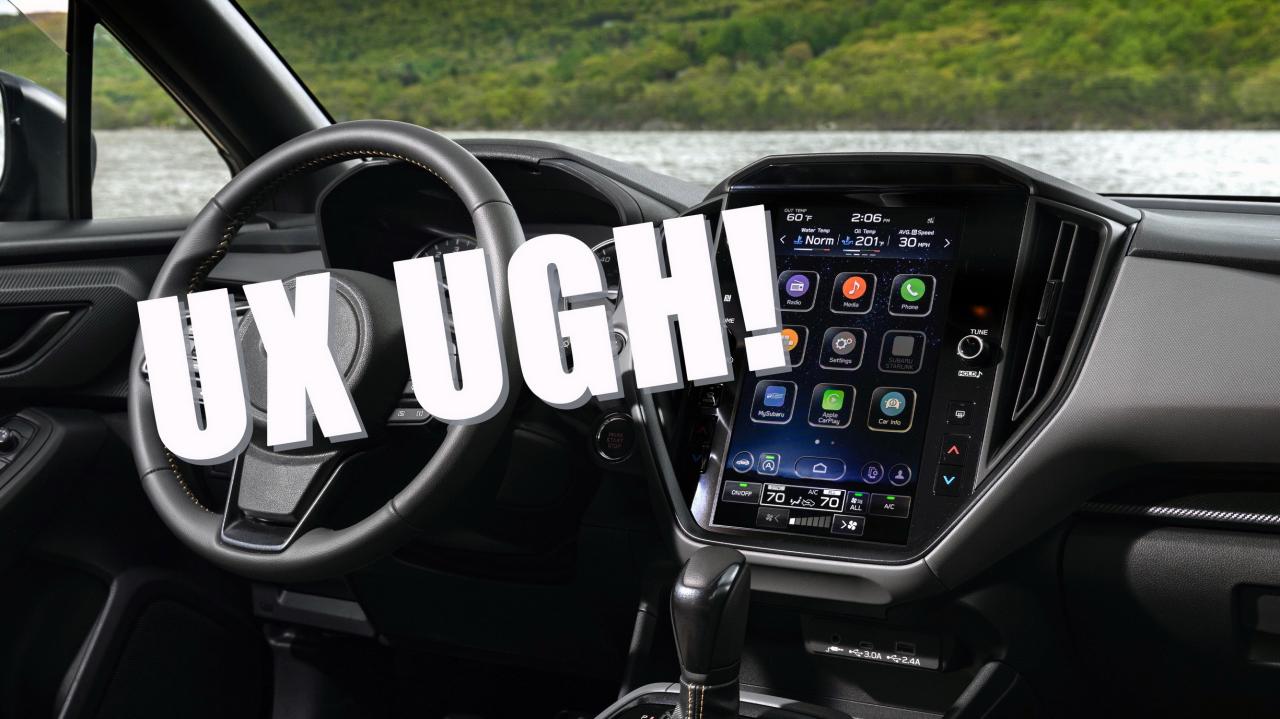
Car Infotainment Systems Trigger Cyber Threat Scare
Car infotainment systems trigger cyber threat scare – that’s the chilling reality facing drivers today. These in-car entertainment and connectivity hubs, while offering convenience and entertainment, are increasingly becoming vulnerable targets for cyberattacks. From simple data breaches to potentially life-threatening control system compromises, the risks are real and growing exponentially as vehicles become more interconnected. This isn’t just about losing your favorite playlist; it’s about the potential for complete vehicle control to fall into the wrong hands.
The vulnerabilities are numerous, ranging from outdated software and poorly secured communication protocols to weak authentication mechanisms. Hackers can exploit these weaknesses to gain access to personal data, steal sensitive information, or even remotely manipulate vehicle functions. Imagine the consequences: your car’s brakes failing, your steering locking up, or your location being tracked without your knowledge. The potential for chaos and harm is significant, making this a crucial issue for drivers, manufacturers, and regulators alike.
Vulnerabilities in Car Infotainment Systems: Car Infotainment Systems Trigger Cyber Threat Scare
The increasing connectivity of modern vehicles, while offering convenience and entertainment, introduces a significant security challenge. Car infotainment systems, the central hubs for navigation, communication, and entertainment, are becoming prime targets for cyberattacks. Their vulnerability stems from a combination of factors, including software weaknesses, outdated security protocols, and the inherent complexity of interconnected systems. Understanding these vulnerabilities is crucial for mitigating the risks they pose.Outdated software is a major contributor to the security risks present in car infotainment systems.
Many systems rely on embedded software that is not regularly updated, leaving them susceptible to known exploits. This is further compounded by the fact that many manufacturers prioritize functionality over security during the initial design and development phases, creating a vulnerable foundation. The long lifecycle of vehicles means that these outdated systems can remain vulnerable for years, even decades, after the car is manufactured.
Common Vulnerabilities in Car Infotainment Systems
Modern car infotainment systems are vulnerable to a range of attacks. These vulnerabilities can be exploited to gain unauthorized access to the system, steal personal data, or even take control of vehicle functions. The consequences can range from minor inconveniences to significant safety hazards.
Consequences of Exploiting Infotainment System Vulnerabilities
Exploiting vulnerabilities in car infotainment systems can have severe consequences. These consequences can be categorized into data breaches, system disruptions, and physical vehicle control compromises. Data breaches can lead to the theft of personal information, such as addresses, financial details, and even driving habits. System disruptions can range from simple glitches and malfunctions to complete system failures, rendering critical functions like navigation and communication unusable.
In the most extreme cases, attackers could potentially gain control of vehicle functions, compromising the safety and security of the driver and passengers. Imagine a scenario where an attacker remotely disables the brakes or steering, the potential for catastrophic consequences is undeniable.
Seriously, the news about car infotainment systems being vulnerable to cyberattacks is freaking me out! It’s a whole new level of connected car chaos. To understand how crucial robust security is becoming, check out this article on bitglass and the rise of cloud security posture management – it highlights the need for proactive security measures, especially as our vehicles become increasingly reliant on cloud connectivity.
This is definitely something we need to address before our cars become remote-controlled targets!
Vulnerability Severity and Impact
The following table summarizes some common vulnerabilities, their severity, and potential impact:
| Vulnerability Type | Severity | Potential Impact | Example |
|---|---|---|---|
| Outdated Software/Operating System | High | Data breach, system malfunction, remote access | Exploiting known vulnerabilities in an outdated Android Auto version to gain access to vehicle data. |
| Unsecured Wi-Fi/Bluetooth | Medium | Data interception, unauthorized access | An attacker intercepting data transmitted over an unsecured Wi-Fi connection to the infotainment system. |
| Weak Passwords/Authentication | Medium | Unauthorized access, data breach | Gaining access to the infotainment system using a default password or a easily guessable password. |
| Insecure Data Storage | High | Data breach, identity theft | Personal data stored on the infotainment system without proper encryption, making it vulnerable to theft. |
| Injection Attacks (SQL, Cross-Site Scripting) | High | System compromise, data manipulation | Injecting malicious code through vulnerable input fields to gain control of the infotainment system. |
Attack Vectors and Methods

Car infotainment systems, while offering convenience and entertainment, present a significant vulnerability point for hackers. Their increasing connectivity and reliance on software create numerous avenues for attack, ranging from simple exploits to sophisticated social engineering schemes. Understanding these attack vectors and methods is crucial for developing effective security measures.The methods used to compromise car infotainment systems are diverse and constantly evolving.
Hackers exploit vulnerabilities in the system’s software, hardware, and communication protocols to gain unauthorized access. This access can range from simple data theft to complete control of vehicle functions, posing significant safety and security risks.
Software Vulnerabilities
Many infotainment systems run on embedded operating systems with known vulnerabilities. These vulnerabilities, often unpatched or poorly managed, can be exploited through malicious software, such as malware designed to take control of the system. For example, a buffer overflow vulnerability in the system’s media player could allow a hacker to execute arbitrary code, potentially gaining root access and control over the entire infotainment system.
This could then be used as a stepping stone to compromise other vehicle systems. Exploiting these flaws often involves sending specifically crafted data packets or files to trigger the vulnerability.
Hardware Exploits
While less common than software exploits, physical access to the infotainment unit can also provide a pathway for attack. Hackers might use specialized tools to directly access the system’s hardware, bypassing software-based security measures. This could involve modifying or replacing components to gain unauthorized access or install malicious firmware. For instance, a hacker with physical access could potentially manipulate the onboard diagnostic (OBD) port to gain control of various vehicle functions.
Communication Protocol Weaknesses
Infotainment systems often communicate with other vehicle systems and external networks via various protocols (e.g., Bluetooth, Wi-Fi, USB). Weaknesses in these protocols can be exploited to gain unauthorized access. For example, a hacker could exploit a vulnerability in the Bluetooth protocol to remotely connect to the infotainment system and install malicious software. Similarly, insecure Wi-Fi configurations can leave the system vulnerable to attacks such as man-in-the-middle attacks, where a hacker intercepts communication between the infotainment system and other devices.
Phishing and Social Engineering
Phishing attacks, involving deceptive emails or messages designed to trick users into revealing sensitive information, can also be used to compromise car infotainment systems. A hacker might send a seemingly legitimate email that prompts the user to click on a malicious link or download an infected file. This can lead to the installation of malware or the compromise of user credentials, potentially granting access to the infotainment system and other vehicle systems.
Social engineering techniques, such as manipulating users into providing access codes or passwords, are also frequently employed. For example, a hacker might pose as a customer service representative to gain access to the system’s settings.
Impact of Cyberattacks on Car Infotainment
The seemingly innocuous car infotainment system, a hub of entertainment and connectivity, can become a significant vulnerability in the face of a successful cyberattack. Its integration with various vehicle functions creates a pathway for malicious actors to disrupt not only the entertainment experience but also crucial aspects of driving safety and personal data security. The consequences extend far beyond a simple system malfunction, impacting drivers, passengers, and the broader automotive landscape.The potential impact of a successful cyberattack on a vehicle’s infotainment system is multifaceted and potentially catastrophic.
Malicious code can exploit vulnerabilities to gain control of various vehicle functions, leading to significant safety risks and serious consequences. The interconnected nature of modern vehicles means that compromising the infotainment system can provide access to other critical systems, creating a cascading effect of malfunctions.
Seriously, the news about car infotainment systems being vulnerable to cyberattacks is freaking me out! It makes you think about the security of all connected devices, and how quickly things can go wrong. Building secure systems is crucial, which is why I’ve been reading up on domino app dev the low code and pro code future – thinking about how those development approaches might impact the security of future car systems.
Ultimately, we need robust solutions to prevent these infotainment system hacks before they become widespread.
Consequences for Drivers and Passengers
A compromised infotainment system can directly impact driver and passenger safety. For example, a successful attack could lead to the disabling of crucial safety features like anti-lock brakes (ABS) or electronic stability control (ESC), dramatically increasing the risk of accidents. Furthermore, attacks could manipulate the vehicle’s navigation system, leading drivers astray or into dangerous situations. Beyond safety, attacks could cause disruptions to the climate control system, leading to passenger discomfort, or even manipulate audio output to create a distraction or disorientation.
In extreme cases, attackers might even gain control of the vehicle’s acceleration or braking systems, resulting in a complete loss of control.
Data Privacy and Security Implications
Modern infotainment systems collect and store a significant amount of personal data, including location history, driving habits, contact information, and potentially even financial details linked to in-car payment systems. A successful cyberattack could expose this sensitive data to unauthorized access, leading to identity theft, financial fraud, and other privacy violations. The breach could also expose intellectual property related to the vehicle’s design and operation.
The scale of potential damage can be immense, particularly considering the volume of data collected over the lifetime of a vehicle and the long-term consequences of data breaches.
Potential Cyberattack Scenarios, Car infotainment systems trigger cyber threat scare
The following scenarios illustrate the varying levels of severity of potential cyberattacks on car infotainment systems. It’s crucial to remember that these are illustrative examples, and the actual impact could vary significantly depending on the specific vulnerabilities exploited and the sophistication of the attack.
The potential consequences range from minor inconveniences to life-threatening situations.
- Minor Inconvenience: A denial-of-service attack temporarily disables access to navigation or entertainment features. This is frustrating but doesn’t directly impact driving safety.
- Significant Disruption: A malicious actor gains access to the vehicle’s climate control system, causing extreme temperatures within the cabin, leading to passenger discomfort and potential health issues.
- Safety Compromise: An attack disables crucial safety features like ABS or ESC, increasing the risk of accidents during emergency braking or maneuvers.
- Complete Vehicle Control: In a worst-case scenario, an attacker gains complete control of the vehicle’s steering, acceleration, and braking systems, potentially leading to a serious accident or even fatalities. This scenario represents the most severe risk, with potential for widespread damage and loss of life.
- Data Breach: Sensitive personal information stored within the infotainment system, such as location data, contact details, and financial information, is stolen and misused. This can have severe long-term consequences for the vehicle owner.
Mitigation Strategies and Security Measures

Protecting car infotainment systems from cyberattacks requires a multi-layered approach encompassing robust design principles, proactive software management, and advanced security technologies. This isn’t just about preventing theft or inconvenience; it’s about ensuring the safety and security of drivers and passengers. Failing to address these vulnerabilities could lead to significant risks, from data breaches to potential vehicle control compromises.
Effective mitigation strategies need to consider the entire lifecycle of the infotainment system, from initial design to ongoing maintenance and updates. This holistic approach is crucial to create a truly secure in-car environment.
Design Security Protocols to Enhance Infotainment System Protection
Secure coding practices are paramount. This includes implementing input validation to prevent buffer overflows and other injection attacks, using secure libraries and avoiding hard-coded credentials. Regular security audits and penetration testing should be conducted throughout the development process to identify and address vulnerabilities before deployment. Furthermore, employing a principle of least privilege, where components only have access to the resources they absolutely require, significantly limits the impact of potential breaches.
A well-defined security architecture, separating the infotainment system from critical vehicle functions, is also essential. For instance, isolating the infotainment network from the CAN bus (Controller Area Network), which controls vital vehicle functions, prevents attackers from leveraging a compromised infotainment system to manipulate the car’s braking, steering, or acceleration.
Best Practices for Software Updates and Patching
Prompt and efficient software updates are crucial. Manufacturers should establish a clear process for identifying, testing, and deploying security patches. Over-the-air (OTA) updates provide a convenient method for delivering these patches directly to vehicles, minimizing the need for physical visits to dealerships. Regular security assessments of the update mechanism itself are also vital to prevent attackers from tampering with the update process and introducing malicious code.
The update process should include robust verification mechanisms to ensure the integrity and authenticity of the software being installed. This could involve digital signatures and checksum verification. Transparency with users about the updates and their security implications is also important to build trust and encourage timely adoption.
Comparison of Security Technologies Available for Vehicle Manufacturers
Several security technologies are available to manufacturers, each with its strengths and weaknesses. Intrusion detection systems (IDS) can monitor network traffic for suspicious activity, alerting manufacturers or drivers to potential attacks. Firewall technology can restrict access to specific parts of the infotainment system or network, limiting the potential damage from a breach. Data encryption protects sensitive data stored on the infotainment system, even if it is compromised.
For example, end-to-end encryption of communication between the infotainment system and external services prevents eavesdropping. Blockchain technology can be employed to enhance the security and integrity of software updates, ensuring that only authorized updates are installed. Finally, hardware-based security modules, like secure elements, offer a higher level of protection by storing cryptographic keys and other sensitive information in a physically protected environment.
The optimal choice depends on factors such as cost, complexity, and the specific security requirements of the infotainment system.
Recommendations for Drivers to Minimize Their Risk
Drivers can also play a significant role in mitigating risks. Keeping the infotainment system’s software updated is crucial. This includes promptly installing all available security patches and updates. Drivers should be wary of connecting to unknown or untrusted Wi-Fi networks, as these can be used to compromise the infotainment system. Avoiding the installation of apps from unverified sources is equally important.
Furthermore, drivers should be cautious about sharing personal information through the infotainment system, limiting the potential impact of a data breach. Strong passwords should be used for any accounts accessed through the infotainment system. Finally, being aware of suspicious activity, such as unexpected pop-ups or unusual network behavior, is crucial for early detection of potential threats.
The Role of Manufacturers and Regulators
The vulnerability of car infotainment systems to cyberattacks presents a significant challenge, demanding a collaborative effort from auto manufacturers and regulatory bodies. The responsibility for securing these systems doesn’t rest solely on one party; instead, it requires a multifaceted approach encompassing design, manufacturing, legislation, and consumer education. The current landscape reveals a disparity in security practices among manufacturers, highlighting the urgent need for standardized security protocols and robust regulatory frameworks.Manufacturers bear the primary responsibility for building secure vehicles.
This involves implementing robust security measures throughout the entire vehicle lifecycle, from design and development to production and post-market updates. Negligence in this area not only compromises consumer safety and privacy but also damages brand reputation and can lead to significant legal liabilities. The cost of rectifying security flaws after a vehicle is released is exponentially higher than integrating security features from the outset.
Manufacturer Responsibilities in Infotainment Security
Auto manufacturers must prioritize the secure design and implementation of infotainment systems. This includes using secure coding practices to minimize vulnerabilities, employing strong encryption protocols to protect sensitive data, and regularly updating software to patch known security flaws. Furthermore, manufacturers should implement robust authentication mechanisms to prevent unauthorized access and employ intrusion detection and prevention systems to monitor and respond to potential threats.
A critical aspect often overlooked is the secure management of the supply chain, ensuring that all components used in the infotainment system are sourced from reliable and secure suppliers. Tesla, for instance, has a reputation for relatively frequent software updates, addressing security concerns proactively, while other manufacturers may lag behind in this aspect.
The Role of Government Regulations in Automotive Cybersecurity
Government regulations play a crucial role in establishing minimum security standards for automotive infotainment systems. These regulations can mandate the use of specific security technologies, require manufacturers to conduct regular security assessments, and establish clear reporting requirements for security incidents. Effective regulations can incentivize manufacturers to prioritize cybersecurity, level the playing field, and ensure a baseline level of protection for consumers.
The European Union’s General Data Protection Regulation (GDPR), while not specifically targeting automotive infotainment, sets a precedent for data privacy regulations that indirectly influence automotive cybersecurity practices. Similar regulatory frameworks are emerging globally, but harmonization across different jurisdictions remains a significant challenge.
Comparison of Security Approaches Across Manufacturers
The approaches to infotainment system security vary significantly among automotive manufacturers. Some manufacturers, like Tesla, are known for their frequent over-the-air software updates and proactive approach to security patching. Others lag behind, offering infrequent updates or lacking robust security features altogether. This disparity reflects differences in investment in cybersecurity, internal expertise, and corporate culture. While some manufacturers prioritize security as a core design principle, others may view it as a secondary concern, potentially leading to vulnerabilities and increased risk.
A detailed comparative analysis of security features across various manufacturers is beyond the scope of this blog post but would be a valuable resource for consumers.
Steps for Improving Automotive Cybersecurity
The following steps are crucial for both manufacturers and regulators to enhance the cybersecurity of automotive infotainment systems:
- Establish industry-wide security standards: Develop and enforce consistent security standards for the design, development, and maintenance of infotainment systems. This would provide a baseline level of security for all vehicles.
- Mandate regular security assessments: Require manufacturers to conduct periodic security assessments of their infotainment systems to identify and address vulnerabilities proactively.
- Implement robust incident reporting mechanisms: Establish clear procedures for reporting and responding to cybersecurity incidents, enabling timely mitigation and preventing widespread attacks.
- Promote secure software development practices: Encourage the adoption of secure coding practices and threat modeling techniques throughout the software development lifecycle.
- Increase consumer awareness: Educate consumers about the risks associated with connected car technology and encourage them to practice safe online habits.
- Foster collaboration and information sharing: Facilitate information sharing between manufacturers, researchers, and regulators to improve collective knowledge and response capabilities.
- Develop and enforce strong data privacy regulations: Ensure that regulations protect consumer data collected and processed by infotainment systems.
- Invest in cybersecurity research and development: Support research efforts aimed at developing innovative security solutions for automotive infotainment systems.
Future Trends and Challenges

The security landscape surrounding car infotainment systems is rapidly evolving, driven by the increasing connectivity and sophistication of these systems. As vehicles become more reliant on software and internet access, the attack surface expands exponentially, presenting significant challenges for manufacturers, regulators, and consumers alike. The future holds both exciting possibilities and serious threats, requiring proactive and adaptive security measures.The integration of advanced driver-assistance systems (ADAS) and autonomous driving features further complicates the security picture.
These systems often rely on real-time data processing and communication, making them vulnerable to manipulation and disruption. The sheer volume of data exchanged between the vehicle and external networks creates an attractive target for cybercriminals seeking to exploit vulnerabilities for financial gain, espionage, or even physical harm.
Emerging Threats and Vulnerabilities
The sophistication of cyberattacks targeting car infotainment systems is steadily increasing. We’re moving beyond simple data breaches to attacks that can directly compromise vehicle functionality. For example, attacks exploiting vulnerabilities in over-the-air (OTA) update mechanisms could allow malicious code to be injected into the vehicle’s software, potentially controlling critical functions like braking or steering. Furthermore, the increasing use of artificial intelligence (AI) in vehicle systems introduces new vulnerabilities, as AI algorithms can be manipulated or poisoned with malicious data, leading to unpredictable and potentially dangerous outcomes.
Exploiting weaknesses in vehicle-to-everything (V2X) communication protocols, allowing attackers to interfere with traffic management systems or even impersonate other vehicles, represents another significant threat.
Challenges in Securing Increasingly Connected Vehicles
Securing increasingly connected vehicles presents numerous challenges. The complexity of modern vehicle architectures, with multiple interconnected systems and software components, makes comprehensive security testing and vulnerability management extremely difficult. The sheer number of potential attack vectors, ranging from external network connections to internal communication buses, further complicates the task. Maintaining software updates across a large fleet of vehicles can also be challenging, especially for older models.
Ensuring the security of third-party software components integrated into infotainment systems is another major hurdle, as these components may have their own vulnerabilities. Finally, the lack of standardized security protocols and regulations across the automotive industry creates a fragmented landscape, making it difficult to implement consistent security measures.
A Future Scenario: A Sophisticated Cyberattack
Imagine a scenario in which a highly connected autonomous vehicle, equipped with advanced ADAS features and V2X capabilities, becomes the target of a sophisticated cyberattack. The attackers, a highly organized group with advanced technical skills, exploit a previously unknown vulnerability in the vehicle’s OTA update mechanism. They inject malicious code disguised as a legitimate software update, gaining control of the vehicle’s braking system and navigation software.
The impact is immediate and devastating. The vehicle, traveling at high speed on a busy highway, suddenly brakes unexpectedly, causing a multiple-vehicle pile-up. Simultaneously, the attackers manipulate the navigation system, rerouting the vehicle to a remote location. The response involves a combination of measures: immediate emergency services deployment to the accident scene, a coordinated effort by vehicle manufacturers and cybersecurity experts to identify and contain the attack, and an investigation by law enforcement to track down the perpetrators.
This scenario highlights the potential for catastrophic consequences if the security of connected vehicles is not given the utmost priority.
Final Summary
The threat of cyberattacks targeting car infotainment systems is no longer a futuristic fantasy; it’s a present-day danger. While the technology behind these systems continues to advance, so too do the sophistication and reach of cyber threats. The responsibility falls on manufacturers to prioritize robust security measures, on regulators to enforce stricter standards, and on drivers to remain vigilant and informed.
Staying updated on software patches, being cautious about connecting to unknown networks, and understanding the potential risks are crucial steps in mitigating this growing threat. The future of safe and secure driving depends on a collective effort to address this challenge head-on.
Detailed FAQs
What are the common signs of a car infotainment system being hacked?
Unusual behavior like the screen freezing, unexpected app downloads, or strange messages appearing could indicate a hack. Also, be wary of any performance issues that weren’t there before.
Can I protect myself from these attacks?
Absolutely! Keep your infotainment system software updated, avoid connecting to public Wi-Fi networks whenever possible, and be cautious about clicking on unknown links or downloading unfamiliar apps.
What should I do if I suspect my car’s infotainment system has been compromised?
Disconnect from any networks immediately. Contact your car manufacturer’s support team and consider reporting the incident to law enforcement if you believe sensitive information has been accessed.
How often should I update my car’s infotainment system?
Check for updates regularly, ideally whenever prompted by your system. Manufacturers often release patches to address known vulnerabilities.
